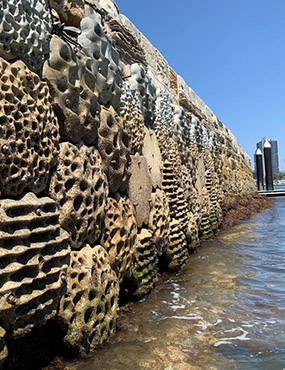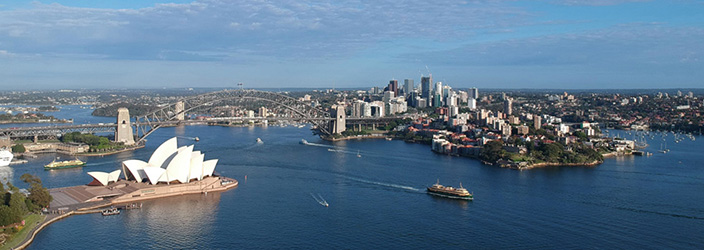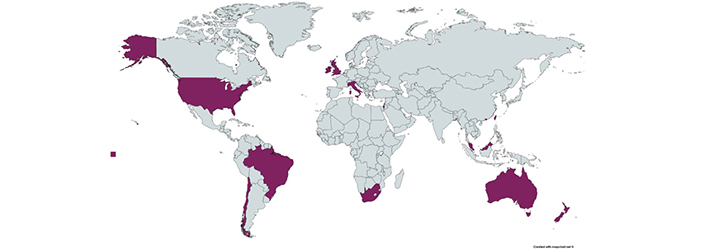A framework for multifunctional eco-engineering
Most artificial structures are built with a single purpose, such as coastal protection, energy or food production, but they can be designed and built for multiple purposes, such as supporting biodiversity and water quality.

Cross-cultural ecology and education
Marine urbanisation presents a global ecological and developmental challenge, having already resulted in significant foreshore modification via seawalls and other structures.
These artificial structures present a range of ecological problems, including:
- replacement of natural habitats
- loss of native species diversity
- the spread of introduced species.
This research has pioneered a framework for multifunctional eco-engineering of new marine infrastructure that contributed to the National Marine Science Plan is being implemented by Lendlease in Sydney.
Evidence collected from extensive surveys, literature review and empirical testing have provided guiding principles for foreshore development at the Sydney Bays Precinct.
Novel eco-engineering applications are also being developed and retrofitted to existing seawalls at increasingly large spatial scales through the ten collaborating countries in the World Harbour Project and the Living Seawalls initiative in Sydney Harbour.
Macquarie University NSW 2109

Dr Katherine Dafforn
Macquarie University
Associate Professor Melanie Bishop
Macquarie University
Dr Maria Vozzo
Sydney Institute of Marine Science
Mr Alex Goad
Reef Design Lab
- state government agencies
- Australian Commonwealth Government
- local government
- general public
- environmental graduates
- biological graduates.
- Living Seawalls
- The Sydney Institute of Marine Science (SIMS)
- The University of New South Wales (UNSW)
- Reef Design Lab
- Lendlease
- The NSW Government
- Volvo
- North Sydney Council
- The University of Sydney
- James Cook University
- The National University of Singapore
- The Australian Government Department of Industry, Innovation and Science
Marine urbanisation is accelerating due to the expansion of coastal cities and efforts to protect assets from threats such as storm surges. Urban, coastal and offshore infrastructure has replaced important habitats such as rocky reef, mangroves and seagrasses. Over ten years of research into this issue has highlighted important ecological consequences of this development including impacts on marine communities from micro- to macro- scales, provision of habitat for invasive species and changes to ecological functions.
In urban seascapes, the practice of 'eco-engineering' is gaining momentum and driving innovative strategies to manage marine infrastructure. Through a combination of survey and experimental work, this research has shown that, similar to 'green roofs', adding native vegetation or fauna to marine infrastructure via seeding or transplants could not only aid in the restoration of degraded habitats, but also minimise the colonisation of unwanted species, such as non-indigenous species.
Eco-engineering has the potential to design structures that not only serve their primary function of foreshore stabilisation and infrastructure protection, but also mitigate impacts and support biodiversity and ecosystem services that benefit coastal dwellers. The eco-engineering framework developed through this research supports the design of multifunctional infrastructure and is informing the Barangaroo South and Bays Precinct developments in Sydney Harbour to restore habitat for biodiversity enhancement, recreation and pollution mitigation. The research was used to underpin a 'White Paper' for the National Marine Science Plan which recommended innovation in eco-engineering to support sustainable marine infrastructure development throughout NSW.
This research has also provided ecological evidence for retrofitting existing structures and contributes to the Living Seawalls flagship project at the Sydney Institute of Marine Sciences. The Living Seawalls project investigates methods to scale up 'greening seawalls' initiatives and add multiple types of habitat enhancing tiles to a single seawall. This is being done in collaboration with Reef Design Lab, a Melbourne-based design studio and installations in Sydney Harbour have been supported by Volvo Australia and North Sydney Council. The research is also expanding globally through an Australia-Singapore collaboration supported by the Global Innovation Strategy program.
The research has been conducted by Dr Katherine Dafforn, Associate Professor Melanie Bishop, Dr Mariana Mayer-Pinto and their teams through collaboration with the Sydney Institute of Marine Science. Four postdoctoral fellows, four PhD, four Masters and one honours student have contributed to this research.
Journal articles
- Mayer-Pinto, M, Dafforn, KA & Johnston, EL (in press 29/6/19) ‘A decision framework for coastal infrastructure to optimize biotic resistance and resilience in a changing climate’ BioScience.
- Ushiama, S, Mayer-Pinto, M, Bugnot, AB, Johnston, EL, & Dafforn, KA (in press 23/7/19) ‘Eco-engineering increases habitat availability and utilization of seawalls by fish’ Ecological Engineering.
- Morris, RL, Golding, S, Dafforn, KA & Coleman, RA 2018, 'Can coir increase native biodiversity and reduce colonisation of non-indigenous species in eco-engineered rock pools?' Ecological Engineering, vol. 120, pp. 622-630. https://doi.org/10.1016/j.ecoleng.2017.06.038.
- Waltham, NJ & Dafforn, KA 2018, 'Ecological engineering in the coastal seascape' Ecological Engineering, vol. 120, pp. 554-559. https://doi.org/10.1016/j.ecoleng.2018.07.028.
- Bugnot, AB, Mayer-Pinto, M, Johnston, EL, Schaefer, N & Dafforn, KA 2018, 'Learning from nature to enhance Blue engineering of marine infrastructure' Ecological Engineering, vol. 120, pp. 611-621. https://doi.org/10.1016/j.ecoleng.2018.03.012.
- Strain, EMA, Olabarria, C, Mayer-Pinto, M, Cumbo, V, Morris, RL, Bugnot, AB, Dafforn, KA, Heery, E, Firth, LB, Brooks, PR & Bishop, MJ 2018, 'Eco-engineering urban infrastructure for marine and coastal biodiversity: which interventions have the greatest ecological benefit?' Journal of Applied Ecology, vol. 55, no. 1, pp. 426-441. https://doi.org/10.1111/1365-2664.12961.
- Bishop, MJ, Mayer-Pinto, M, Airoldi, L, Firth, LB, Morris, RL, Loke, LHL, Hawkins, SJ, Naylor, LA, Coleman, RA, Chee, SY & Dafforn, KA 2017, 'Effects of ocean sprawl on ecological connectivity: impacts and solutions' Journal of Experimental Marine Biology and Ecology, vol. 492, pp. 7-30. https://doi.org/10.1016/j.jembe.2017.01.021.
- Heery, EC, Bishop, MJ, Critchley, LP, Bugnot, AB, Airoldi, L, Mayer-Pinto, M, Sheehan, EV, Coleman, RA, Loke, LHL, Johnston, EL, Komyakova, V, Morris, RL, Strain, EMA, Naylor, LA & Dafforn, KA 2017, 'Identifying the consequences of ocean sprawl for sedimentary habitats' Journal of Experimental Marine Biology and Ecology, vol. 492, pp. 31-48. https://doi.org/10.1016/j.jembe.2017.01.020.
- Dafforn, KA 2017, 'Eco-engineering and management strategies for marine infrastructure to reduce establishment and dispersal of non-indigenous species' Management of Biological Invasions, vol. 8, no. 2, pp. 153-161. https://doi.org/10.3391/mbi.2017.8.2.03.
- Mayer-Pinto, M, Johnston, EL, Bugnot, AB, Glasby, TM, Airoldi, L, Mitchell, A & Dafforn, KA 2017, 'Building ‘blue’: an eco-engineering framework for foreshore developments' Journal of Environmental Management, vol. 189, pp. 109-114. https://doi.org/10.1016/j.jenvman.2016.12.039.
- Dafforn, KA, Mayer-Pinto, M, Morris, RL & Waltham, NJ 2015, 'Application of management tools to integrate ecological principles with the design of marine infrastructure' Journal of Environmental Management, vol. 158, pp. 61-73. https://doi.org/10.1016/j.jenvman.2015.05.001.
- Dafforn, KA, Glasby, TM, Airoldi, L, Rivero, NK, Mayer-Pinto, M & Johnston, EL 2015, 'Marine urbanization: an ecological framework for designing multifunctional artificial structures' Frontiers in Ecology and the Environment, vol. 13, no. 2, pp. 82-90. https://doi.org/10.1890/140050.
- Dafforn, KA, Glasby, TM & Johnston, EL 2012, 'Comparing the invasibility of experimental "reefs" with field observations of natural reefs and artificial structures' PLoS ONE, vol. 7, no. 5, e38124, pp. 1-16. https://doi.org/10.1371/journal.pone.0038124.
- Dafforn, KA, Johnston, EL & Glasby, TM 2009, 'Shallow moving structures promote marine invader dominance' Biofouling, vol. 25, no. 3, pp. 277-287. https://doi.org/10.1080/08927010802710618.
Reports
Dafforn, KA, Mayer-Pinto, M, Bugnot, AB, Coleman, RA, Morris, RL & Johnston, EL 2016, ‘Guiding principles for marine foreshore developments’. Prepared for UrbanGrowth NSW.
Dafforn, KA, Mayer-Pinto, M, Morris, R & Waltham, N 2014, ‘White Paper on Green Engineering and Marine Urban Development’ Prepared for the National Marine Science Plan.
Popular press
Dafforn KA, Bugnot AB, Heery E, Mayer-Pinto M. Future ‘ocean cities’ need green engineering above and below the waterline. The Conversation 26/03/2018.
Dafforn KA, Mayer-Pinto M, Waltham N. Our oceans are out of balance – can we learn some tips from feng shui. The Conversation 8/9/16.
Dafforn KA, Johnston EL, Bank J, Mayer-Pinto M. Concrete coastlines: it’s time to tackle our marine urban sprawl. The Conversation 16/03/2015.
Countries where impact occurred
The USA, Brazil, Chile, the UK, Ireland, Italy, Israel, South Africa, Taiwan, Malaysia, Australia, New Zealand.
